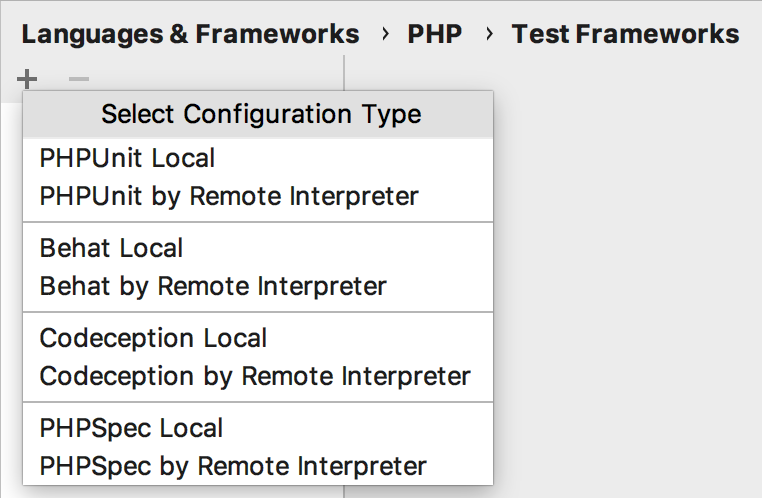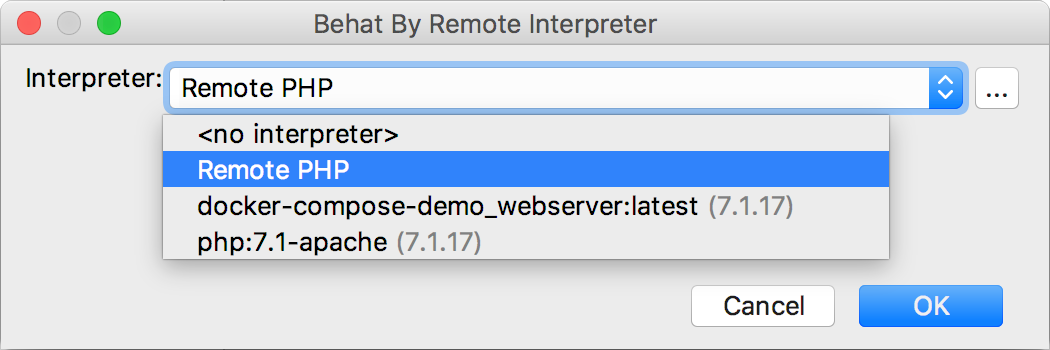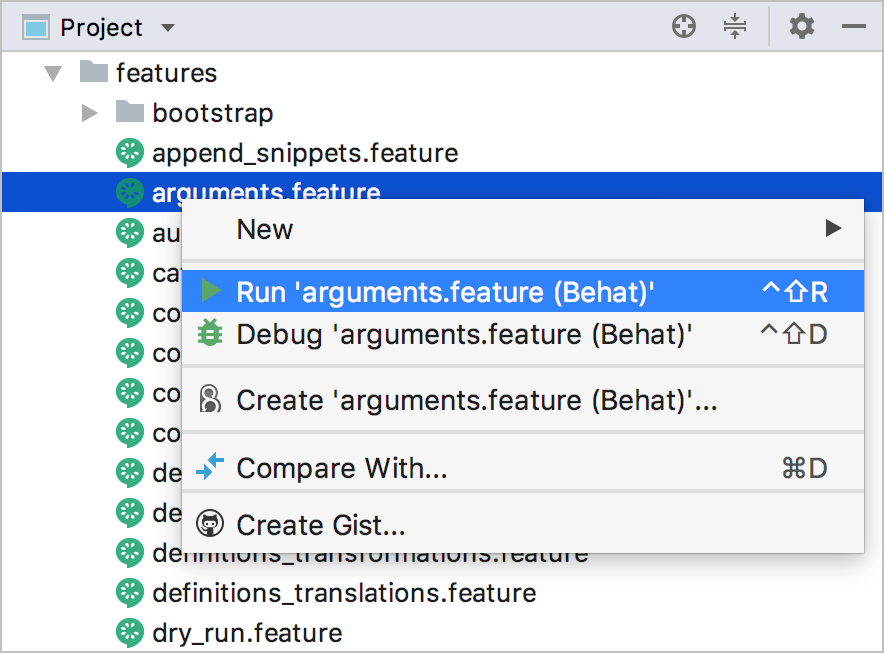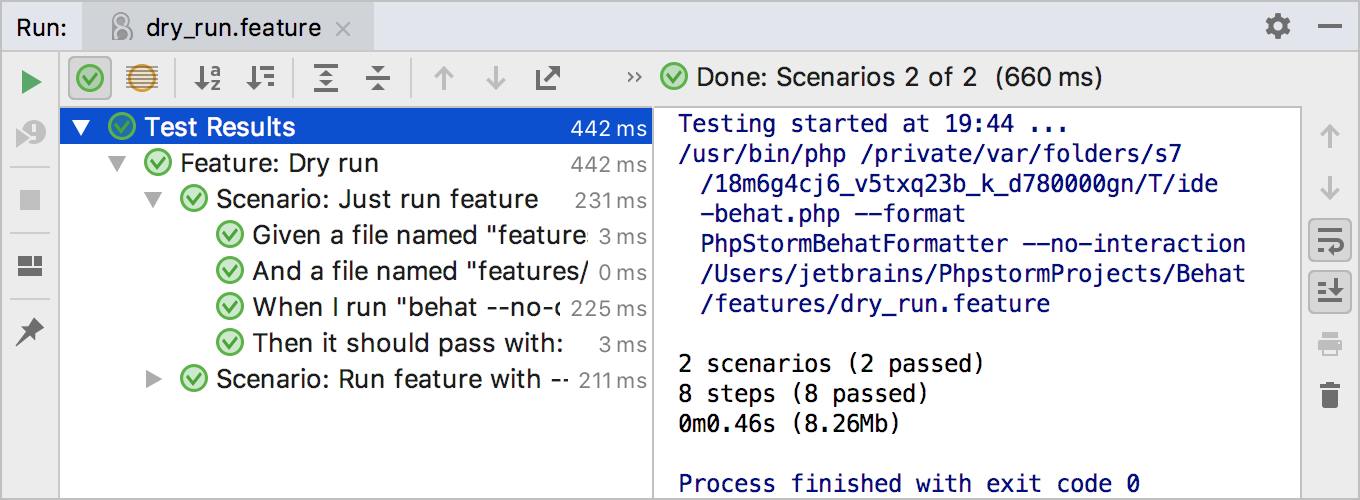Testing with Behat
With IntelliJ IDEA, you can practice behaviour-driven development by running scenarios using the Behat framework. Currently IntelliJ IDEA supports integration with Behat 3 and Behat 2 versions.
Native support of Behat in IntelliJ IDEA includes:
Recognition of and coding assistance for .feature scenario files and .php scenario definition files.
Support of Gherkin syntax in .feature files:
Feature,Scenario,Given,When,Then,And, andButkeywords.Recognition of
@given,@when, and@thenannotations in definition files.Setting correspondence between scenarios and their definitions through regular expressions in accordance with the PCRE standard for Behat 2.4 and PCRE+ for Behat 3.0. Turnip expressions are also welcome.
Before you start
Make sure the PHP interpreter is configured in IntelliJ IDEA on the PHP page, as described in Configuring Local PHP Interpreters and Configuring Remote PHP Interpreters. Note that Behat 3 requires PHP 5.5 and higher.
Make sure the PHP and Behat plugins are installed and enabled. The plugins are not bundled with IntelliJ IDEA, but they can be installed from the JetBrains plugin repository as described in Managing Plugins. Once enabled, the plugins are available at the IDE level, that is, you can use them in all your IntelliJ IDEA projects.
Downloading and installing Behat
To download Behat installation package manually
-
Download behat.phar from the Behat Downloads page and save it on your computer:
If you need full coding assistance in addition to the ability of running Behat tests, store behat.phar under the root of the project where Behat will be later used.
If you only need to run Behat tests and you do not need any coding assistance, you can save behat.phar outside the project.
To download and install Behat with Composer
On the context menu of composer.json, choose . Alternatively choose from the main menu.
- In the Manage Composer Dependencies Dialog that opens, select the
behat/behatpackage from the Available Packages list, possibly using the search field. The list shows all the available packages; the packages that are already installed are marked with a checkmark.Choose the relevant version from the Version to install list.
If necessary, expand the Settings hidden area and specify the advanced installation options. In the Command line parameters field, type the additional command line parameters.
Click Install.
Learn more about installing Behat from Behat Official website.
Integrating Behat with IntelliJ IDEA in a project
-
In the Settings/Preferences dialog (Ctrl+Alt+S), expand the node and select under .
On the Test Frameworks page that opens, click
 in the central pane and choose the configuration type from the list:
in the central pane and choose the configuration type from the list: 
-
In local configurations the default project PHP interpreter is used, see Default project CLI interpreters for details.
-
To use Behat with a remote PHP interpreter, choose one of the configurations in the dialog that opens:

-
-
In the Behat Library area, specify the location of the Behat executable file or behat.phar archive.
Click next to the Path to Behat directory or phar file field. IntelliJ IDEA detects the version of Behat and displays it below the field.
next to the Path to Behat directory or phar file field. IntelliJ IDEA detects the version of Behat and displays it below the field. - In the Test Runner area, appoint the configuration .yml file to use for launching and executing scenarios.
By default, Behat looks for a behat.yml configuration file in the project root folder or in the config folder. You can appoint a custom configuration file.Clear the Default configuration file checkbox to have Behat use the behat.yml configuration file from the project root folder or from the config folder. If no such file is found, test execution fails, therefore it may be more reliable to specify the configuration file explicitly.
- Select the Default configuration file checkbox to specify your own .yml configuration file. This file will be later used as default in all Behat run/debug configurations.
In the field, specify the location of the configuration file to use. Type the path manually or click
 and choose the file in the dialog box that opens.
and choose the file in the dialog box that opens.
Running and debugging Behat tests
For information about writing Behat features, refer to the Behat Documentation.
To run or debug Behat tests
- In the Project tool window, select the feature file to run your tests from and choose Run '<feature file>' or Debug '<feature file>' on the context menu of the selection:

IntelliJ IDEA generates a default run configuration and starts a run/debug test session with it.
To save an automatically generated default configuration
After a test session is over, choose Save <default_test_configuration_name> on the context menu of the file or folder.
To create a custom run/debug configuration
In the Project tool window, select the file or folder with the tests to run and choose Create run configuration on the context menu. Alternatively, choose on the main menu, then click
 and choose Behat from the list.
and choose Behat from the list. In the Run/Debug Configuration: Behat dialog that opens, specify the scenarios to run and customize the behavior of the current PHP interpreter by specifying the options and arguments to be passed to the PHP executable file.
Monitoring Behat test results
IntelliJ IDEA shows the tests execution results in the Test Runner tab of the Run Tool Window. The tab is divided into 2 main areas. In the left-hand area you can drill down through all unit tests to see the succeeded and failed ones. You can also filter tests, export results, and use the context menu commands to run specific tests or navigate to the source code.
The right-hand area displays the raw Behat output:
